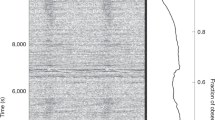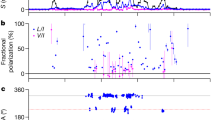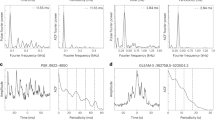Abstract
PSR1237 + 25, one of the first pulsars to be discovered1,2, is characterized by a striking five-peaked integrated intensity profile. Like many other pulsars, PSR1237 + 25 also exhibits the puzzling phenomena of drifting subpulses, ‘nulling’ and ‘mode-switching’. The period of pulsation is 1.38 s, but the radio-emission occurs within an 80 ms interval. We have analysed single-pulse data from this pulsar at 430 MHz to throw light on the still obscure mechanism of pulsar emission. We conclude that the behaviour of PSR1237 + 25 can be explained on the polar-cap model if regular short (S) bursts spiralling in towards the magnetic pole are occasionally interrupted by long (L) bursts along the magnetic axis.
This is a preview of subscription content, access via your institution
Access options
Subscribe to this journal
Receive 51 print issues and online access
$199.00 per year
only $3.90 per issue
Buy this article
- Purchase on Springer Link
- Instant access to full article PDF
Prices may be subject to local taxes which are calculated during checkout
Similar content being viewed by others
References
Backer, D. C. Nature 228, 752 (1970).
Backer, D. C. Nature 228, 1295 (1970).
Radhakrishnan, V. & Cooke, D. J. Astrophys. Lett. 3, 225 (1969).
Backer, D. C. thesis, Cornell Univ. (1972).
Backer, D. C. Astrophys. J. 182, 245 (1973).
Taylor, J. H., Machester, R. N. & Huguenin, G. R. Astrophys. J. 195, 513 (1975).
Lockwood, E. H. A Book of Curves (Cambridge University Press, 1961).
Thompson, D. W. On Growth and Form (Cambridge University Press, 1971).
Kahn, P. G. K. & Pompea, S. M. Nature 275, 606 (1978).
Backer, D. C. Astrophys. J. 209, 895 (1976).
Unwin, S. C., Readhead, A. C. S., Wilkinson, P. N. & Ewing, M. S. Mon. Not. R. astr. Soc. 182, 711 (1978).
Lyne, A. G. Mon. Not. R. astr. Soc. 153, 27P (1971).
Morris, D., Sieber, N., Ferguson, D.C. & Bartel, N. Astr. Astrophys. (in the press).
Oster, L. & Sieber, W. Astr. Astrophys. 58, 303 (1977).
Sturrock, P. A. Astrophys. J. 164, 529 (1971).
Ruderman, M. A. & Sutherland, P. Astrophys. J. 196, 51 (1975).
Cheng, A. F. & Ruderman, M. A. Astrophys. J. 235, 576 (1980).
Jones, P. B. Mon. Not. R. astr. Soc. 184, 807 (1978).
Erber, T. Rev. Mod. Phys. 38, 626 (1966).
Richtings, R. T. Mon. Not. R. astr. Soc. 176, 249 (1976).
Taylor, J. H., Fowler, L. A. & McCulloch, P. M. Nature 277, 437 (1979).
Author information
Authors and Affiliations
Rights and permissions
About this article
Cite this article
Hankins, T., Wright, G. A study of PSR1237 + 25 at 430 MHz. Nature 288, 681–684 (1980). https://doi.org/10.1038/288681a0
Received:
Accepted:
Issue Date:
DOI: https://doi.org/10.1038/288681a0
Comments
By submitting a comment you agree to abide by our Terms and Community Guidelines. If you find something abusive or that does not comply with our terms or guidelines please flag it as inappropriate.



